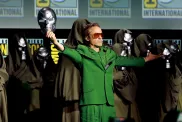
On the cusp of his Miskatonic London lecture, SHOCK talks to author and Headpress co-founder David Kerekes
David Kerekes is an authority on death and sex on screen. A co-founder of Headpress, the British publishing house specializing in invaluable and essential texts on unpopular culture, Kerekes two books co-written with fellow Headpress architect David Slater are exhaustive and indispensible: SEE NO EVIL: BANNED FILMS AND VIDEO CONTROVERSY (2001) investigates Britains video nasties moral panic, with an opening chapter offering the best thorough summary Ive yet read on the rise, popularization and dominance of home video (from a UK perspective). Slater & Kerekes earlier co-authorship, the critically acclaimed KILLING FOR CULTURE: AN ILLUSTRATED HISTORY OF DEATH FILM FROM MONDO TO SNUFF (1994), has recently been revised and greatly expanded for a new 2016 edition, under the title KILLING FOR CULTURE: FROM EDISON TO ISIS A NEW HISTORY OF DEATH ON FILM. The Hardback Edition is available direct from the Headpress website (EMBED LINK: http://www.headpress.com/ShowProduct.aspx?ID=117), with the paperback edition to follow in June 2016.
The Miskatonic Institute of Horror Studies is a non-profit forum for established horror writers, directors, scholars, film programmers and curators to discourse with genre fans in a critical, curriculum-based, academic setting. Founded by Kier-La Janisse (author of HOUSE OF PSYCHOTIC WOMEN: AN AUTOBIOGRAPHICAL TOPOGRAPHY OF FEMALE NEUROSIS IN HORROR AND EXPLOITATION CINEMA and Festival Director & Head Programmer for Melbournes Monster Fest, the Miskatonic Institute named after the Arkham University of H.P. Lovecraft mythos has hosted pop-up courses, lectures and screenings all over the world, with regular curriculums operating yearly in Montreal, Canada and London, England.
In London, the next course on the block at The Horse Hospital is David Kerekes Its Not Real, But Its Reality: The Story of Custom-Made Sex and Horror, taking place this Thursday, May 12th, from 7:00PM-10:00PM. Pulling from Kerekes research for KILLING FOR CULTURE, this lecture traces the history of the custom film shoot, where customers script and pay for their own movies, usually with niche fetish specifications, including models being mock executed. Often enhanced by digital effects and sometimes featuring explicit sex, these short films closely mimic the motifs of the mythological snuff film, in as much as the customer suggests a scenario, the preferred mode of death (gunshot, strangulation, hanging, etc.) and the victim (plucked from a studios own roster of performers).
SHOCK speaks with David Kerekes, one of the preeminent researchers of human horror and its tangled connection with cinema entertainment.


KEREKES: There are several instances in which websites containing such material have been closed down, either by hosting companies or law enforcement. There are also instances where the producers of such material have landed in court. In Britain in 2008, a law was passed that directly addressed the issue of fake snuff material. A test case came to trial in 2011 involving a man who had paid for and downloaded such images. The issue of realism is key in trying to determine whether fake snuff pictures can be classed as obscene or not. Other factors are also involved, of course, but this new law referred to colloquially as The Dangerous Pictures Act hinges on the rather nebulous concept of what is real. In the test case, the defendant was found not guilty.
As to how producers themselves circumvent the law they dont always manage to do so. However, these studios are operating globally, and I suspect the local obscenity laws under which some of them are working may be more lax than in, say, the UK, the US, and Canada.
SHOCK: In your course description, you say that custom video makers are “patronized by individuals with a hankering to see a favorite model hiccup in white socks, or else, more likely, be executed and play dead. Do you really think that the extreme end of sex/murder/violence is the most often requested material from these on-demand film production companies? And how do these custom shoots connect with the snuff narrative and panic of the 1970s?
KEREKES: Custom shoots extend beyond just fake snuff, of course or death fetish as they are also known. It seems to me that theres a rise in the number of non-death fetish clips being produced to order, especially of a niche and idiosyncratic type. But generally I would say they are not nearly as widespread, and they certainly dont have the network in place that the death fetish community has. This is based on our research putting together KILLING FOR CULTURE, and my subsequent research undertaken for this particular lecture.
If you look back to the snuff film panic of the mid 1970s, the rumors followed a very specific model: snuff films were said to be films that featured a genuine murder, and that these films were created and sold for the sexual gratification of a very select and wealthy client base. The rumors by and large went unchallenged well, they certainly didnt go away once they had taken hold in the media, and the Hollywood imagination and that of society as a whole, despite no evidence of a snuff film being found. What impact do these rumors have on society? I dont mean in the sense of a moral panic, but what long-term impact? How do we answer those rumors? Well, one answer it seems to me is to create snuff films of our own albeit fake ones as per the custom shoot.
For London SHOCK readers, ticket links for David Kerekes Its Not Real, But Its Reality: The Story of Custom-Made Sex and Horror as well as past & future courses from the Miskatonic Institute of Horror Studies can be found HERE.
HEADPRESS and their extensive collection of film & culture publications and related ephemera and curiosities can be found HERE.






